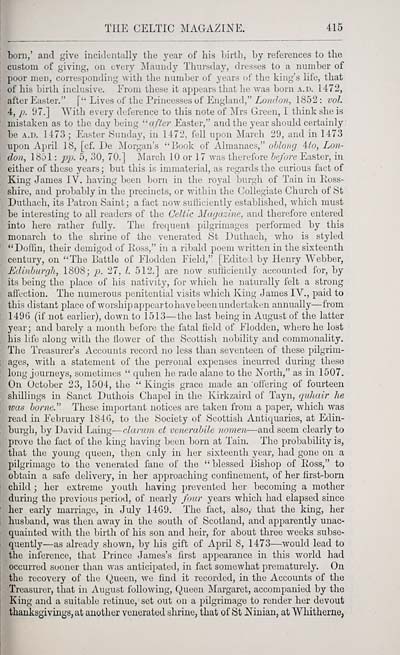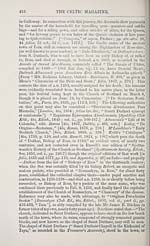Blair Collection > Celtic magazine > Volume 3
(425)
Download files
Complete book:
Individual page:
Thumbnail gallery: Grid view | List view

THE CELTIC MAGA2ilNE. 415
■born,' and give incidentally the year of his birth, by references to the
custom of giving, on every JMaundy Thursday, dresses to a number of
poor men, corresponding with the number of years of the king's life, that
of his birth inclusive. From these it appears that he was born a.d. 1472,
after Easter." ['' Lives of the Princesses of England," io/icfoji, 1852: vol.
4, p. 97.] With every deference to this note of Mrs Green, I think she is
mistaken as to the day being "■after Easter," and the year should certainly
be A.D. 1473 ; Easter Sunday, in 1472, fell upon March 29, and in 1473
upon April 18, [cf. De Morgan's "Book of Almanacs," ohlong Uo, Lon-
don, 1851 : P2X 5, 30, 70.] March 10 or 17 was therefore before Easter, in
either of these years; but this is immaterial, as regards the curious fact of
King James IV. having been born in the royal burgh of Tain in Koss-
shire, and probably in the precincts, or within the Collegiate Church of St
Duthach, its Patron Saint; a fact now suliiciently established, which must
be interesting to all readers of the Celtic Alagazlne, and therefore entered
into here rather fully. The frecpient pilgrimages performed by this
monarch to the shrine of the venerated St Dathach, who is styled
"Dofiin, their demigod of Koss," in a ribald poem written in the sixteenth
century, on "The Battle of Elodden Eield," [Edited by Henry Webber,
Edinburgh, 1808; p. 27, I. 512.] are now sufficiently accounted for, by
its being the place of his nativity, for which he naturally felt a strong
aflection. The numerous penitential visits which King James IV., paid to
this distant place of worship appear to have been undertaken annually — from
149G (if not earlier), down to 1513 — the last being in August of the latter
year; and barely a month before the fatal field of Elodden, where he lost
his life along with the flower of the Scottisli nobility and commonality.
The Treasurer's Accounts record no less than seventeen of these pilgrim-
ages, with a statement of the per?onal expenses incurred during these
long journeys, sometimes " quhen he rade alane to the North," as in 1507.
On October 23, 1504, the " Kingis grace made an "offering of fourteen
shillings in Sanct Duthois Chapel in the Kirkzaird of Tayn, quhalr he
tvas borne." These important notices are taken from a paper, which was
read in February 1846, to the Society of Scottish Antiquaries, at Edin-
burgh, by David Laing— cZarwm et venerablle nojnen — and seem clearly to
prove the fact of the king having been born at Tain. The probability is,
that the young queen, then only in her sixteenth year, had gone on a
pilgrimage to the venerated fane of the "blessed Bishop of Eoss," to
obtain a safe delivery, in her approaching confinement, of her first-born
child ; her extreme youth having prevented her becoming a mother
during the previous period, of nearly four years which had elapsed since
her early marriage, in July 1469. The fact, also,- that the king, her
husband, Avas then away in the south of Scotland, and apparently unac-
quainted with the birth of his son and heir, for about three weeks subse-
quently — as already shown, by his gift of April 8, 1473 — would lead to
the inference, that Prince James's first appearance in this world had
occurred sooner than was anticipated, in fact somewhat prematurely. On
the recovery of the C^ueen, Ave find it recorded, in the Accoimts of the
Treasurer, that in August following, Queen Margaret, accompanied by the
King and a suitable retinue, set out on a pilgrimage to render her devout
thanksgivings, at another venerated shrine, that of St Ninian, at Whitherne,
■born,' and give incidentally the year of his birth, by references to the
custom of giving, on every JMaundy Thursday, dresses to a number of
poor men, corresponding with the number of years of the king's life, that
of his birth inclusive. From these it appears that he was born a.d. 1472,
after Easter." ['' Lives of the Princesses of England," io/icfoji, 1852: vol.
4, p. 97.] With every deference to this note of Mrs Green, I think she is
mistaken as to the day being "■after Easter," and the year should certainly
be A.D. 1473 ; Easter Sunday, in 1472, fell upon March 29, and in 1473
upon April 18, [cf. De Morgan's "Book of Almanacs," ohlong Uo, Lon-
don, 1851 : P2X 5, 30, 70.] March 10 or 17 was therefore before Easter, in
either of these years; but this is immaterial, as regards the curious fact of
King James IV. having been born in the royal burgh of Tain in Koss-
shire, and probably in the precincts, or within the Collegiate Church of St
Duthach, its Patron Saint; a fact now suliiciently established, which must
be interesting to all readers of the Celtic Alagazlne, and therefore entered
into here rather fully. The frecpient pilgrimages performed by this
monarch to the shrine of the venerated St Dathach, who is styled
"Dofiin, their demigod of Koss," in a ribald poem written in the sixteenth
century, on "The Battle of Elodden Eield," [Edited by Henry Webber,
Edinburgh, 1808; p. 27, I. 512.] are now sufficiently accounted for, by
its being the place of his nativity, for which he naturally felt a strong
aflection. The numerous penitential visits which King James IV., paid to
this distant place of worship appear to have been undertaken annually — from
149G (if not earlier), down to 1513 — the last being in August of the latter
year; and barely a month before the fatal field of Elodden, where he lost
his life along with the flower of the Scottisli nobility and commonality.
The Treasurer's Accounts record no less than seventeen of these pilgrim-
ages, with a statement of the per?onal expenses incurred during these
long journeys, sometimes " quhen he rade alane to the North," as in 1507.
On October 23, 1504, the " Kingis grace made an "offering of fourteen
shillings in Sanct Duthois Chapel in the Kirkzaird of Tayn, quhalr he
tvas borne." These important notices are taken from a paper, which was
read in February 1846, to the Society of Scottish Antiquaries, at Edin-
burgh, by David Laing— cZarwm et venerablle nojnen — and seem clearly to
prove the fact of the king having been born at Tain. The probability is,
that the young queen, then only in her sixteenth year, had gone on a
pilgrimage to the venerated fane of the "blessed Bishop of Eoss," to
obtain a safe delivery, in her approaching confinement, of her first-born
child ; her extreme youth having prevented her becoming a mother
during the previous period, of nearly four years which had elapsed since
her early marriage, in July 1469. The fact, also,- that the king, her
husband, Avas then away in the south of Scotland, and apparently unac-
quainted with the birth of his son and heir, for about three weeks subse-
quently — as already shown, by his gift of April 8, 1473 — would lead to
the inference, that Prince James's first appearance in this world had
occurred sooner than was anticipated, in fact somewhat prematurely. On
the recovery of the C^ueen, Ave find it recorded, in the Accoimts of the
Treasurer, that in August following, Queen Margaret, accompanied by the
King and a suitable retinue, set out on a pilgrimage to render her devout
thanksgivings, at another venerated shrine, that of St Ninian, at Whitherne,
Set display mode to: Large image | Transcription
Images and transcriptions on this page, including medium image downloads, may be used under the Creative Commons Attribution 4.0 International Licence unless otherwise stated. ![]()
| Early Gaelic Book Collections > Blair Collection > Celtic magazine > Volume 3 > (425) |
|---|
| Permanent URL | https://digital.nls.uk/76448266 |
|---|
| Description | Volume III, 1878. |
|---|---|
| Shelfmark | Blair.4 |
| Attribution and copyright: |
|
| Description | A selection of books from a collection of more than 500 titles, mostly on religious and literary topics. Also includes some material dealing with other Celtic languages and societies. Collection created towards the end of the 19th century by Lady Evelyn Stewart Murray. |
|---|
| Description | Selected items from five 'Special and Named Printed Collections'. Includes books in Gaelic and other Celtic languages, works about the Gaels, their languages, literature, culture and history. |
|---|

